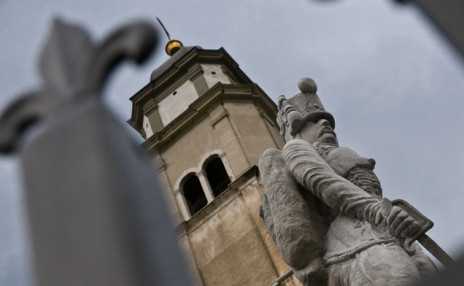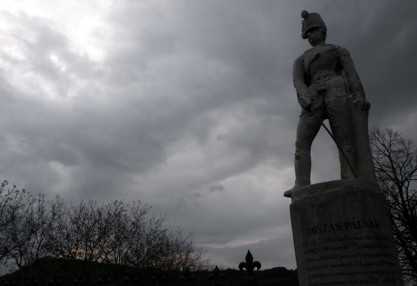Statue Unveiling Ceremony in Memory of the Hussar Hero
Szöveg: honvedelem.hu / MTI | 2013. november 23. 10:33Dr. Csaba Hende, Minister of Defence of Hungary and Roman Jakič, Minister of Defence of the Republic of Slovenia inaugurated together the statue of the Hungarian Hussar Pál Rostás on Friday, November 15, in the Slovenian Budanje, where he died a hero’s death two hundred years ago. The statue was renovated by public contributions.

Minister of Defence Dr. Csaba Hende: “Pál Rostás executed a heroic act"
It was impossible to hold the ceremony on the spot owing to the extraordinarily high wind, the two Ministers could only lay their wreaths at the statue and after the blessings of the church, the commemoration took place in the nearby Vipava barracks, in the presence of many hundreds of participants. The ambassadors and diplomats of many countries to Ljubljana, the representatives of the Slovenian Parliamentary parties, the leaders and inhabitants of the neighbouring settlements as well as the members of the Hungarian and Slovenian re-enactment groups attended the event.
The Hungarian Minister of Defence in his festive address recalled that the Hungarian Hussars were outstanding in their tactics, as the elite soldiers of the era. Two hundred years ago, four Hungarian Hussars escorted the marching past of an ambulance wagon, when Pál Rostás “executed a heroic act", he sacrificed his own life to save the casualties’ life. His statue is standing in this place, not because in Budapest or in Ljubljana somebody so decided, but because the people living here wanted to re-erect it. This heroic act is not the only common thing in our past. In the course of the thousand years of our history we both lived through the hardships of communism and attained our freedom, and became the members of the EU and NATO. The Minister of Defence pointed out that Pál Rostás ties us together the same way as the memory of WW1, the next year’s anniversary offers a good opportunity for us to remember those who shed their blood 100 years ago.

The renovated statue of the Hungarian Hussar Pál Rostás Pál in Budanje, Slovenia
The Slovenian Minister of Defence Roman Jakič in his speech underlined that the monument of Pál Rostás is evidence, that his comrades “liked and appreciated his professional military knowledge and his human character". He mentioned that in the renovation of the statue, many people participated with their individual efforts and voluntary work with Hungarian and Slovenian collaboration.
On October 3, 1813, in the battles against Napoleon’s forces, Pál Rostás was fighting against 60 French infantrymen and seven cavalrymen as an ordinary Hussar of the 5th Radetzky Hussar Regiment. The inhabitants of the then Wippach – today Vipava – had been eye-witnesses of his heroic fight against the enemy in superior numbers, therefore – after the French left -, they instituted a funeral with full honours to the dead hero, and erected a monument over his grave. From the donations of the local inhabitants and the one-time comrades, a life-size statue was set up in 1845. Though the occupying Italian soldiers fatally damaged the work-of-art in 1920, it still became the example of the anti-Italian resistance and the hero of Slovenia at the same time. The locals saved the damaged fragments of the statue, and reserved them in the Lapidarium of the Nova-Gorica Museum until recently.

The memory of the Hungarian Hussar has not been forgotten for two hundred years
The Budanje Cultural Association turned to the Hungarian Embassy in 2009, initiating the statue’s renovation. The Slovenian civil organisation rebuilt the pedestal with voluntary work from local contributions by 2011. For the restoration of the statue and the rehabilitation of its environs, a collection started from early 2012 at the initiative of the Hungarian Embassy in Ljubljana and the ‘József Attila’ Cultural Association, in cooperation with the Budakeszi Culture Foundation.
Half of the works costing around 20 thousand Euros was financed from Slovenian support; the other half was covered from the donations of the Hungarians. The Hungarian Ministry of Foreign Affairs provided a one and a half million-forint fund, while the defence portfolio gave half million forints and one million forints were collected from the donations of the civil organisations, settlements, private persons living beyond and within the borders of Hungary.
Photo by Péter Snoj